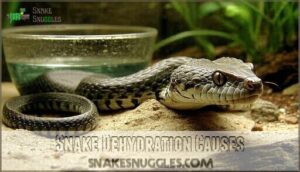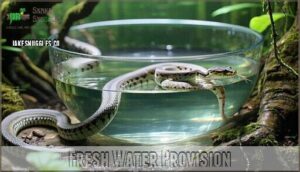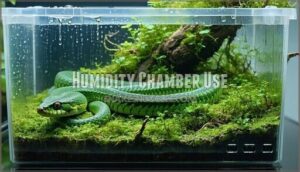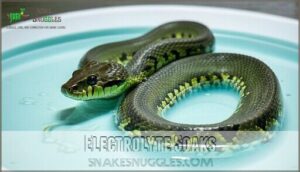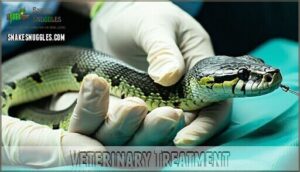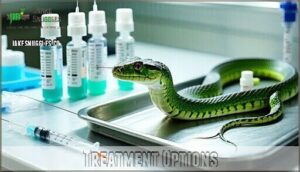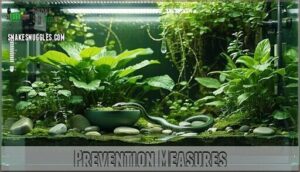This site is supported by our readers. We may earn a commission, at no cost to you, if you purchase through links.
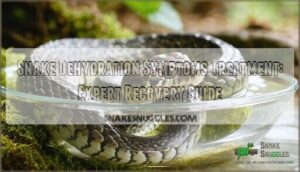 You’ll spot snake dehydration symptoms treatment needs when your pet shows wrinkled, tent-like skin that doesn’t snap back quickly, sunken eyes, and unusual lethargy.
You’ll spot snake dehydration symptoms treatment needs when your pet shows wrinkled, tent-like skin that doesn’t snap back quickly, sunken eyes, and unusual lethargy.
Start treatment immediately with fresh water access and increased humidity around 60-80%. Create a humidity chamber using damp moss or towels, and offer lukewarm water soaks for 10-15 minutes daily.
Monitor your snake’s response closely – healthy hydration should restore skin elasticity within 24-48 hours. Severe cases require veterinary fluid therapy to prevent organ damage.
The key lies in recognizing subtle early warning signs before your snake reaches a critical state, which is crucial for effective dehydration symptoms treatment and ensuring the snake’s overall health, including preventing organ damage.
Table Of Contents
- Key Takeaways
- Snake Dehydration Causes
- Dehydration Symptoms
- Rehydration Strategies
- Treatment Options
- Prevention Measures
- Frequently Asked Questions (FAQs)
- What Kind of Diet Should I Feed My Snake to Prevent Dehydration?
- What Are the Long Term Effects of Dehydration in Snakes?
- How Often Should I Check My Snake for Signs of Dehydration?
- What Temperature Should I Keep My Snake’s Enclosure to Prevent Dehydration?
- Is Dehydration in Snakes Preventable?
- How to treat a dehydrated snake?
- How do you know if a snake is dehydrated?
- What are two warning signs of dehydration?
- Can snakes have Pedialyte?
- How long does snake dehydration recovery take?
- Conclusion
Key Takeaways
- You’ll recognize dehydration symptoms through visible symptoms like wrinkled skin that doesn’t bounce back, sunken eyes, lethargy, and shedding problems that require immediate attention.
- Start treatment right away with lukewarm water soaks (80-84°F) for 15-30 minutes daily and boost humidity levels to 60-80% using damp moss or towels.
- Prevention works better than treatment—maintain proper humidity levels for your snake’s species, provide fresh water consistently, and monitor their environment daily.
- Severe dehydration needs veterinary care with fluid therapy since delayed treatment can cause organ damage and potentially fatal complications.
Snake Dehydration Causes
Understanding what causes snake dehydration is essential for keeping your reptile healthy and preventing serious health complications.
Several factors can lead to dehydration, from simple environmental issues to more complex underlying health problems that require immediate attention.
Snake dehydration strikes fast—catch it early, treat it quickly.
This includes recognizing the signs of dehydration to take prompt action and ensure the well-being of your pet.
Lack of Water Access
When your snake can’t reach fresh water, dehydration strikes fast.
Water bowl size matters—it should accommodate your snake’s body for drinking and soaking.
Poor water bowl placement in hard-to-reach spots limits access.
Multiple snakes need multiple water sources to prevent competition.
Clean water bowls weekly to encourage drinking, as dirty water deters hydration and worsens snake dehydration symptoms.
Incorrect Humidity Levels
Your snake’s enclosure humidity levels can make or break their health.
Low ambient humidity accelerates water loss through osmosis, while improper humidity control creates a breeding ground for dehydration.
Use hygrometer calibration to monitor levels accurately, and adjust misting frequency based on your enclosure size and substrate choice.
Humidity management isn’t guesswork—it’s precision.
Underlying Illnesses
Some illnesses can sneakily drain your snake’s water reserves faster than you’d expect.
Kidney disease disrupts fluid balance, while parasitic infections cause diarrhea and fluid loss.
Respiratory issues reduce your snake’s ability to stay hydrated, and metabolic disorders affect organ function.
These underlying health issues make snake dehydration symptoms worse and require immediate veterinary treatment for proper snake dehydration treatment.
Environmental Factors
Your snake’s environment plays a major role in preventing dehydration.
Poor substrate choice, inadequate enclosure size, and improper temperature gradients create stress that accelerates water loss. Water quality issues and insufficient lighting needs compound these problems.
Key environmental factors affecting snake dehydration:
- Temperature Gradient – Extreme heat or cold forces your snake’s body to work harder, increasing fluid loss
- Humidity Control – Low ambient moisture pulls water directly from your snake’s skin and respiratory system
- Substrate Choice – Overly dry bedding absorbs moisture from the air and your snake’s body
- Water Quality – Contaminated or chemically treated water discourages drinking and may cause digestive issues.
Mimicking the snake’s natural environment helps, especially regarding humidity and temperature.
Species-Specific Needs
Different snake species have wildly different hydration requirements based on their natural habitats.
Your snake’s natural habitat determines everything from humidity needs to drinking habits.
Tropical species like ball pythons need 60-80% humidity, while arid species like rosy boas thrive at 30-40%.
Arboreal snakes often refuse standing water, preferring mist droplets.
Understanding your snake’s specific needs through proper habitat mimicry prevents dehydration symptoms and guarantees proper enclosure design with appropriate water quality.
Maintaining appropriate humidity is key to preventing reptile dehydration and ensures proper enclosure design with appropriate water quality, which helps in preventing dehydration symptoms.
Dehydration Symptoms
Recognizing dehydration symptoms early can save your snake‘s life and prevent serious health complications.
You’ll notice telltale signs like wrinkled skin, sunken eyes, and difficulty shedding that signal your pet needs immediate attention.
Wrinkled Skin
Wrinkled skin serves as your first visual warning that your snake is experiencing dehydration. This dehydration indicator appears when fluid loss causes the skin to lose its normal elasticity and smooth texture.
You’ll notice several key changes in scale appearance and skin condition:
- Skin elasticity test: Gently pinch the skin – it stays folded instead of snapping back
- Scale appearance: Loose, saggy, or puckered texture replaces the normal smooth look
- Identifying severity: More pronounced wrinkling indicates advanced dehydration stages
- Preventative care: Regular visual checks help catch early signs before serious complications
This snake dehydration symptom requires immediate attention to prevent your dehydrated snake from developing more severe health issues.
Dry Eyes
Your snake’s eyes reveal dehydration through several telltale signs.
Sunken eyes appear dented or recessed into the skull, while cracked eye caps create visible fissures across the surface.
These eye condition changes signal serious fluid loss.
Dry mouth often accompanies these snake dehydration symptoms, increasing infection risk and potential vision impairment.
Monitor for corneal damage requiring immediate attention, as it can be a critical indicator of the snake’s overall health, potentially leading to vision impairment.
Lethargy
While dry eye conditions signal surface dehydration, lethargy reveals deeper snake dehydration symptoms affecting your pet’s entire system.
Energy depletion becomes obvious when your normally active snake barely moves. You’ll notice slow movement patterns and reduced activity levels throughout the day.
Muscle weakness develops as dehydration progresses, creating apathy signs that can’t be ignored. Treating snake dehydration quickly restores normal snake health and activity levels.
Shedding Difficulties
Dehydrated snakes often struggle with their shedding process, creating a frustrating cycle.
You’ll notice stuck shed patches, especially around eye caps, nose, and tail areas.
This condition, called dysecdysis, happens when humidity impact reduces skin flexibility.
Snake dehydration makes the shedding frequency irregular and incomplete, and skin patches remain attached instead of peeling off cleanly, requiring immediate attention to prevent complications.
The result is a need for careful management to address dehydration and support the snake’s health during shedding.
Behavioral Changes
When your snake’s usual routine goes haywire, you’re witnessing classic dehydration symptoms.
Appetite loss often strikes first, followed by reduced activity and unusual hiding behavior.
You might notice erratic movements or changes in basking patterns.
These behavior changes signal your snake’s distress and need immediate attention.
Reduced activity can also indicate significant lethargy.
If these snake health warning signs persist, schedule a veterinary consultation promptly to address the issue of dehydration symptoms and ensure your snake receives proper care for its distress.
Rehydration Strategies
When your snake shows signs of dehydration, quick action can make all the difference between a full recovery and serious health complications.
You’ll need to combine immediate hydration methods with long-term environmental adjustments to restore your snake’s health and prevent future episodes, using immediate action for the best results.
Fresh Water Provision
Now that you’ve recognized snake dehydration symptoms, providing fresh water becomes your first line of defense.
Water bowl size matters—choose one large enough for your snake to soak comfortably. Clean water bowls every 2-3 days to prevent bacterial growth.
Water source type should be dechlorinated or filtered. Strategic water bowl placement near the warm side encourages drinking.
Multiple bowls help guarantee consistent water access throughout the enclosure for superior snake hydration.
Humidity Chamber Use
While fresh water helps, creating a humidity chamber gives you better control over your snake’s recovery environment.
Set up a humid hide using a plastic container with ventilation holes, lined with damp sphagnum moss or paper towels.
Maintain humidity levels between 80-90% inside the chamber. Different species require varying duration guidelines – monitor your snake’s response and adjust accordingly.
Check chamber materials daily, replacing wet substrates to prevent mold growth. A pre-made snake hide offers a convenient alternative.
Electrolyte Soaks
Nothing beats electrolyte soaks for treating snake dehydration symptoms.
Mix one teaspoon concentrate per gallon of warm water at 80-84°F bath temperature. Soak duration should last 10-15 minutes for your snake species.
This rehydration therapy restores essential minerals while monitoring hydration levels. Solution concentration matters—too strong can stress reptiles.
Electrolyte soak treatments work faster than plain water alone. Chronic dehydration can lead to severe electrolyte imbalances and requires immediate attention, as detailed in this resource: severe electrolyte imbalances.
Warm Water Soaks
Warm water soaks provide immediate relief for dehydrated snakes.
Here’s how to administer this rehydration therapy safely:
- Water Temperature: Heat water to 80-84°F (27-28°C) for ideal comfort
- Soak Duration: Allow 15-30 minutes depending on dehydration severity
- Snake Monitoring: Watch for stress signs throughout the process
- Soak Frequency: Repeat daily until hydration improves
Use a shallow container where your snake can rest comfortably without submerging its head.
Veterinary Treatment
While water soaks help mild cases, severe dehydration requires professional snake veterinary treatment.
Your reptile vet will assess dehydration levels and provide targeted snake rehydration therapy.
Fluid therapy delivers balanced crystalloids through subcutaneous or intracoelomic routes, antibiotic injections address underlying infections, while parasite control eliminates fluid-draining organisms.
Assisted feeding supports weakened snakes, and wound care prevents complications during recovery.
Treatment Options
When your snake shows dehydration symptoms, you’ll need to act quickly with the right treatment approach.
Professional veterinary care combined with proper home management can save your pet’s life and restore their health.
Fluid Therapy
When soaks aren’t enough, your vet may recommend fluid therapy. This medical intervention delivers precise hydration directly into your snake’s system through various administration routes.
- Subcutaneous fluids – injected under the skin for moderate dehydration
- Intravenous fluids – delivered directly into bloodstream for severe cases
- Oral rehydration – administered by mouth for mild dehydration
- Electrolyte infusions – balanced solutions that restore essential minerals
- Fluid types – ranging from saline to specialized reptile formulations
Professional snake rehydration therapy guarantees your pet receives the right amount and type of fluids based on their specific condition and dehydration severity.
Regular monitoring of the snake’s weight and skin condition changes is also vital during recovery.
Medication
Antibiotics like ceftazidime and enrofloxacin combat bacterial infections that worsen dehydration.
Antiparasitics target intestinal parasites causing fluid loss.
Anti-inflammatories reduce pain and stress that limit drinking behavior.
Your vet’ll prescribe reptile-safe electrolytes and immune boosters alongside medication.
Pain management keeps your snake comfortable during recovery.
Always combine reptile medication with proper electrolyte therapy for maximum effectiveness, and ensure to follow the prescribed treatment to keep your snake comfortable during the recovery process.
Humidity Control
Since proper humidity levels prevent further moisture loss, you’ll need consistent monitoring with hygrometer accuracy checks.
Maintain 60-80% humidity using misting systems, moisture-retaining substrate choice, and humid hides.
Create humidity gradients across your enclosure size while ensuring adequate ventilation needs.
This humidity control approach supports your snake’s recovery without overwhelming their system.
Temperature Regulation
Temperature regulation creates the foundation for proper hydration recovery.
Maintain basking spots at 88-92°F and cool areas around 78-82°F to establish healthy thermal gradients.
Use heating pads under one-third of the enclosure for consistent warmth.
Night temperatures can drop 5-10 degrees safely, and it is crucial to monitor temperature accurately.
Install digital thermometers for accurate temperature monitoring and adjust heating elements as needed.
Hydration Monitoring
Your snake’s drinking frequency reveals vital dehydration clues.
Watch for decreased water bowl visits and monitor urates observation – healthy snakes produce white, chalky waste.
Test skin elasticity by gently pinching; dehydrated skin won’t snap back.
Weight tracking helps catch gradual fluid loss early.
Behavior changes like lethargy signal trouble brewing.
Prevention Measures
You can prevent dehydration in your snake by setting up the right environment and paying close attention to their needs.
It’s easier to stop problems before they start than to play catch-up with a thirsty snake.
Research Species Needs
Prevention starts with understanding your snake’s blueprint for success. Each species evolved in specific environments with unique hydration behaviors and dietary water needs. Ball pythons from West African grasslands require different care than corn snakes from southeastern forests.
Here’s your research checklist:
- Natural habitat – Study your snake’s wild home for humidity and temperature ranges
- Enclosure setup – Match substrate, hiding spots, and water features to species needs
- Temperament considerations – Shy species need secure water access without stress
- Hydration behaviors – Some snakes soak regularly while others rarely drink visibly
- Snake species requirements – Desert snakes need 30-40% humidity versus tropical species needing 70-80%
Proper research prevents snake dehydration symptoms and eliminates guesswork from snake dehydration treatment. To guarantee superior well-being, mimic native ecosystems.
Provide Humid Hides
You’ll need humid hides to prevent snake dehydration symptoms in your pet.
Set up these microhabitats using sphagnum moss or damp paper towels inside plastic containers. Location Matters—place them on the warm side of your enclosure.
Hide Materials should retain moisture without creating soggy conditions. Consider purchasing a suitable snake product for ideal humidity.
Different Species Variation means tropical snakes need permanent humid hides, while others benefit during Shedding Success periods.
Hide Maintenance involves checking moisture levels weekly to support proper snake care.
Maintain Optimal Humidity
Beyond providing humid hides, you’ll need to monitor your snake’s environment closely.
Proper humidity monitoring keeps your pet healthy and prevents dehydration-related problems.
- Hygrometer Placement – Position digital hygrometers at both warm and cool ends of the enclosure
- Substrate Choice – Use moisture-retaining materials like cypress mulch or coconut husk
- Misting Frequency – Spray enclosures 1-2 times daily, adjusting based on readings
- Enclosure Ventilation – Balance airflow to prevent stagnant air while maintaining humidity levels
Regulate Temperature
Temperature control keeps your snake comfortable and properly hydrated.
Set basking spot temps between 88-95°F using heating pad safety guidelines.
Create temperature gradients from warm to cool sides.
Maintain nighttime temperatures 5-10 degrees lower.
Use accurate thermostats for temperature regulation techniques.
Poor temperature management strategies cause stress and dehydration.
Temperature optimization through proper thermostat accuracy prevents health issues.
Monitor Health Changes
Regular check-ups catch snake dehydration symptoms early.
Watch for weight fluctuations, reduced appetite changes, and decreased activity levels.
Test skin elasticity weekly—healthy skin snaps back quickly.
Monitor eye appearance changes and examine urates for thick, white consistency.
Document behavior changes like lethargy or unusual hiding.
These observations help you spot dehydration before it becomes serious.
Frequently Asked Questions (FAQs)
What Kind of Diet Should I Feed My Snake to Prevent Dehydration?
Frozen/thawed prey contains 70% more moisture than live prey.
You should feed your snake frozen/thawed rodents instead of live ones, as they retain higher water content and help maintain proper hydration levels naturally.
What Are the Long Term Effects of Dehydration in Snakes?
Chronic dehydration causes kidney damage, organ failure, immune system weakness, heart problems, and metabolic imbalances.
You’ll see muscle wasting, chronic constipation, and poor wound healing.
Severe cases can be fatal without treatment.
How Often Should I Check My Snake for Signs of Dehydration?
Just like checking your car’s oil, you should examine your snake weekly for dehydration signs. Look for wrinkled skin, sunken eyes, and stuck shed during routine handling sessions.
What Temperature Should I Keep My Snake’s Enclosure to Prevent Dehydration?
Maintain temperatures between 75-85°F with proper basking spots.
Your snake needs species-specific ranges – too hot or cold forces extra energy use, increasing dehydration risk through stress and improper body function.
Is Dehydration in Snakes Preventable?
Yes, dehydration’s absolutely preventable with proper care. You’ll need to maintain species-appropriate humidity levels, provide fresh water daily, monitor temperatures closely, and research your snake’s specific environmental needs thoroughly.
How to treat a dehydrated snake?
Soak your snake in lukewarm water (80-84°F) for 15-30 minutes daily. Increase enclosure humidity to 60-70% and provide fresh water. For severe cases, seek veterinary care immediately.
How do you know if a snake is dehydrated?
Wrinkled skin, sunken eyes, and stuck shed reveal dehydration’s grip. Check skin elasticity—pinch gently. If it doesn’t snap back, your snake needs immediate rehydration through soaking and humidity adjustments.
What are two warning signs of dehydration?
Look for wrinkled skin that doesn’t snap back when gently pinched, and sunken or dull eyes. These two signs clearly show your snake’s losing essential fluids and needs immediate attention.
Can snakes have Pedialyte?
Roughly 70% of dehydrated reptiles recover fully with proper treatment.
You can use diluted Pedialyte for snakes, but it’s safer to stick with plain water soaks or veterinary-approved electrolyte solutions designed specifically for reptiles.
How long does snake dehydration recovery take?
Recovery time depends on dehydration severity.
Mild cases improve within days with proper soaking and humidity adjustments.
Moderate dehydration takes one to two weeks.
Severe cases need veterinary care and may require several weeks to recover from severe dehydration.
Conclusion
Remarkably, studies show that 30% of captive snakes experience dehydration issues at least once during their lifetime.
Successful snake dehydration symptoms treatment depends on quick recognition and prompt action. You’ve learned to identify warning signs like wrinkled skin and lethargy, plus effective treatment methods including humidity chambers and water soaks.
Remember that prevention beats treatment every time. Monitor your snake’s environment daily, maintain proper humidity levels, and provide fresh water consistently.
With these tools, you’ll keep your serpent companion healthy and hydrated for years ahead, ensuring a long and healthy life with your serpent companion.

